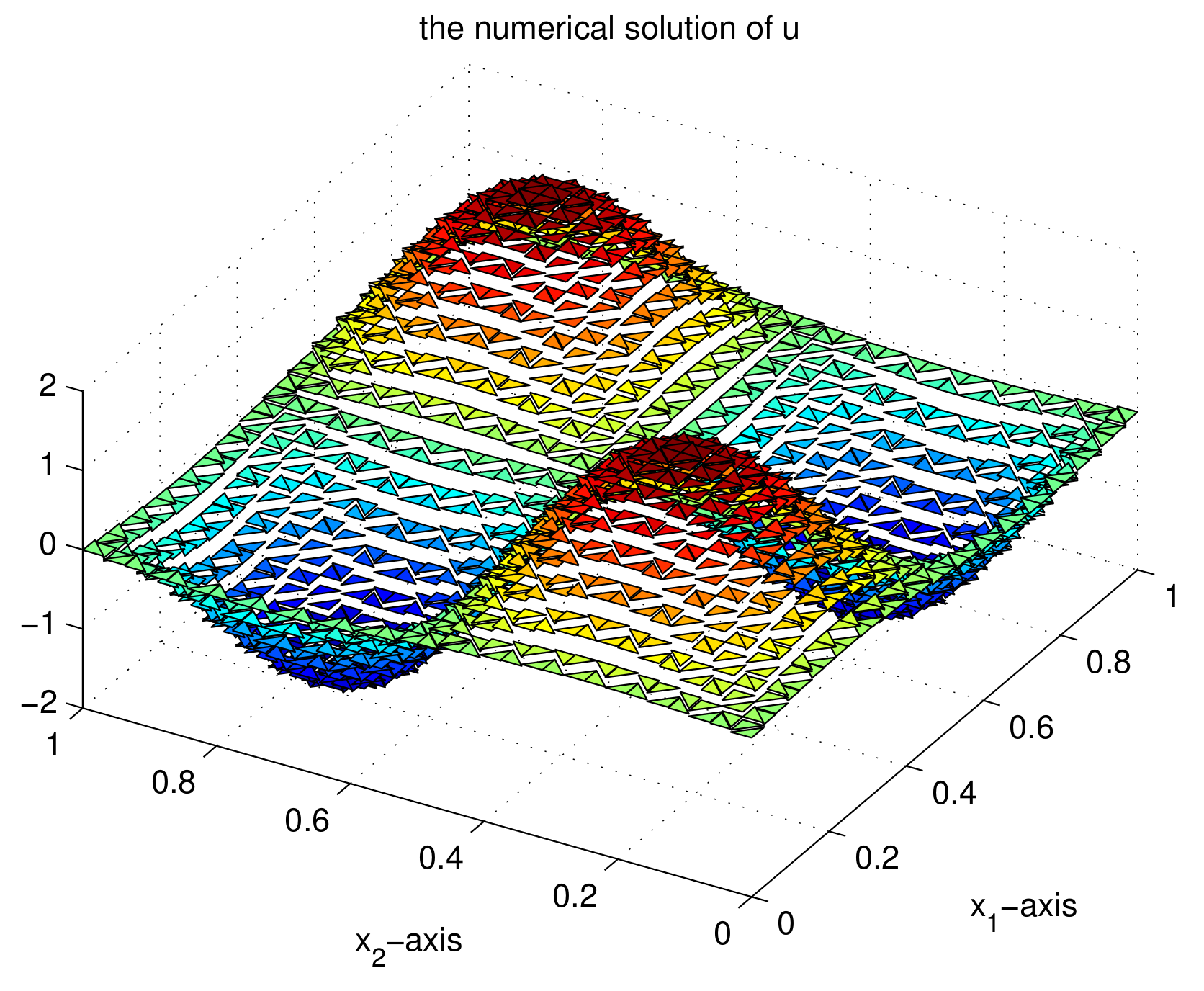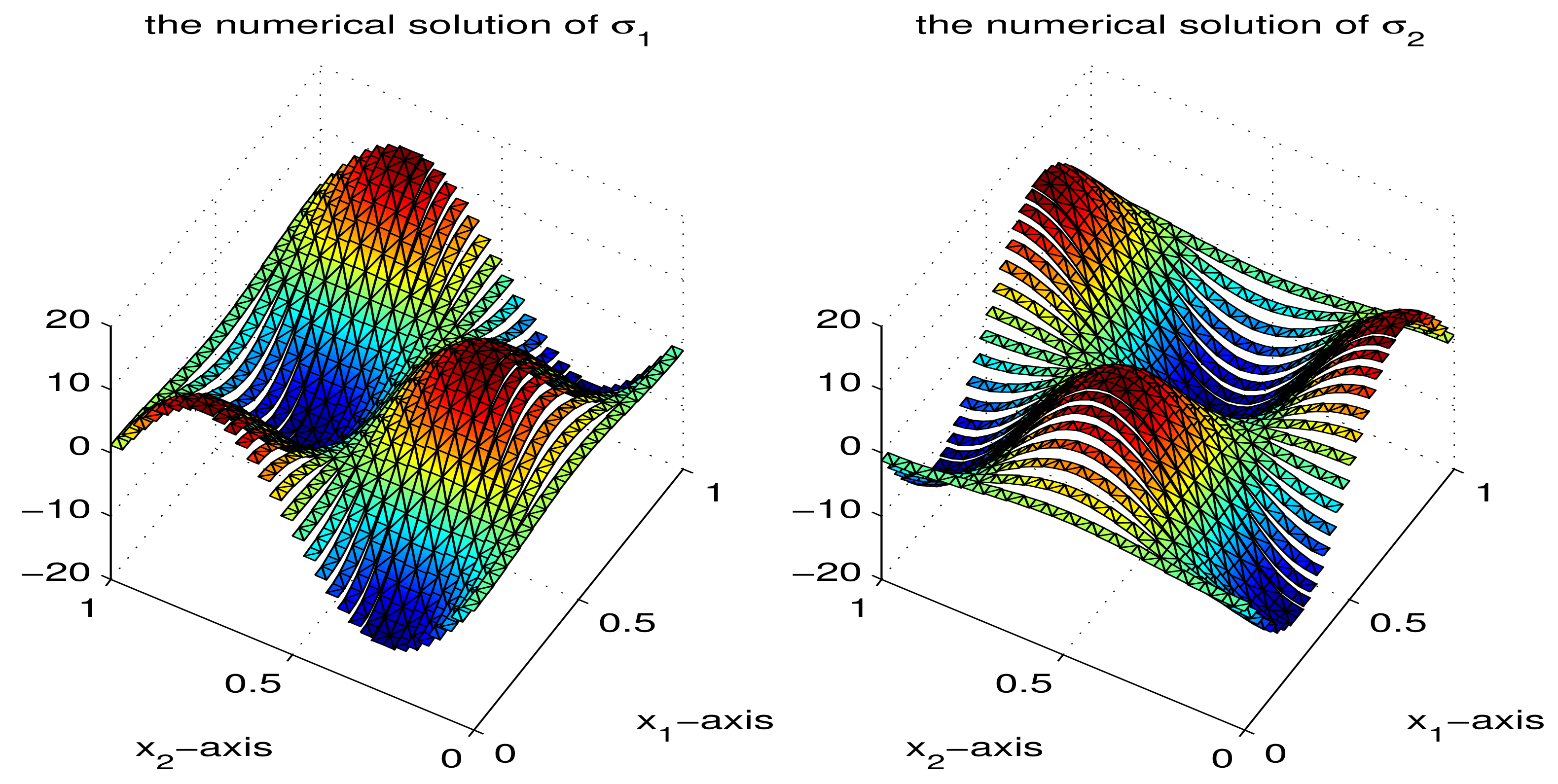1. Introduction
Fractional partial differential equations (FPDEs) have received more and more attention from scholars in the fields of science and engineering because of their various practical applications [
1,
2,
3,
4,
5,
6]. Therefore, theoretical research and some problems of the solutions of FPDEs have been closely studied by many scholars [
7,
8,
9,
10,
11]. However, there are still many FPDEs for which it is difficult to obtain analytic solutions. Thus, a lot of numerical techniques have been constructed and studied to solve FPDEs [
12,
13,
14,
15,
16,
17,
18,
19,
20,
21,
22], including finite difference (FD) methods, finite element (FE) methods, mixed finite element (MFE) methods, spectral methods, (local) discontinuous Galerkin (L)DG methods and so on.
In recent years, finite volume (FV) and finite volume element (FVE) methods have been used to solve FPDEs by many scholars. Wang and Du [
23] constructed a fast locally conservative FV method to solve steady-state space-fractional diffusion equations with Riesz fractional derivatives. Hejazi et al. [
24,
25] provided an FV method for the time-space two-sided fractional advection-dispersion equation and space fractional advection-dispersion equation, respectively. Zhuang et al. [
26] proposed FV and FE methods for the space-fractional Boussinesq equation with Riemann-Liouville derivatives on a one-dimensional domain. Yang et al. [
27] constructed an FV scheme with pretreatment Lanczos method to solve two-dimensional space fractional reaction-diffusion equations. Cheng et al. [
28] provided an Eulerian-Lagrangian control volume method to solve the space-fractional advection-diffusion equations with Caputo fractional derivatives. Feng et al. [
29] proposed an FV scheme to treat the two-sided space-fractional diffusion equation with Riemann-Liouville fractional derivatives. Jia and Wang [
30,
31] constructed fast FV schemes for two kinds of space-fractional differential equations, respectively. Simmons et al. [
32] proposed an FV method to solve two-sided fractional diffusion equations with Riemann-Liouville derivatives. Jiang and Xu [
33] constructed a monotone FV scheme to solve the time-fractional Fokker-Planck equation. Karaa et al. [
34] proposed an FVE method to solve two-dimensional fractional subdiffusion problems with the Riemann-Liouville derivative. Karaa and Pani [
35] applied an FVE method to solve the time-fractional diffusion equations with nonsmooth initial data.
In this article, we will develop a mixed finite volume element (MFVE) method to solve the time-fractional reaction-diffusion equations as follows
where
is a bounded convex polygonal domain with boundary
,
with
. The functions
,
and
are smooth enough, the diffusion coefficient
. And there exist constants
and
such that
.
is the Caputo fractional derivative defined by
Our aim is to construct an MFVE scheme [
36,
37,
38,
39,
40,
41] by combining the MFE method [
42,
43,
44,
45] with the FVE method [
46,
47,
48,
49,
50,
51] to treat the time Caputo fractional reaction-diffusion equation. The MFVE method can not only simultaneously compute several different quantities but also maintain the local conservativity, which is very important in computational fluid dynamics. In this article, we apply the
-formula [
52,
53] to approximate the Caputo fractional derivative, introduce a vector-valued auxiliary variable to rewrite the model equation as the first-order coupled system, and approximate this coupled system by the MFVE method. We use the lowest order Raviart-Thomas (
) space and the piecewise constant function space as the trial function spaces of the vector-valued auxiliary variable and scalar unknown variable, respectively. In terms of theoretical analysis, we give the existence, uniqueness and stability analysis, and obtain
a priori error estimates for the scalar unknown variable (in
-norm) and the vector-valued auxiliary variable (in
-norm and
-norm). Further, we give two numerical examples in one-dimensional and two-dimensional spatial regions to verify the feasibility and effectiveness of the proposed scheme.
The remaining structure of the article is as follows. In
Section 2, we present a fully discrete MFVE scheme for the time-fractional reaction-diffusion equation by introducing transfer operator
and the
-formula of approximating the Caputo fractional derivative. In
Section 3, the properties of transfer operator and truncation errors of
-formula are given, and the generalized MFVE projection and its estimates are introduced. The existence, uniqueness, stability and convergence analysis for the MFVE scheme are analyzed in
Section 4 and
Section 5, respectively. Two numerical examples are given to verify the feasibility and effectiveness in
Section 6. Throughout the article, we use the standard notations and definitions of the Sobolev spaces as in Reference [
54]. The mark
C will denote a generic positive constant which is independent of the spatial mesh parameter
h and time discretization parameter
.
2. Fully Discrete MFVE Scheme
In order to formulate the MFVE approximate scheme, we introduce an auxiliary variable
, and rewrite the problem (
1) as
The associated mixed variational formulation of (
3) is to find {
u,
}:
such that
where
.
Now, we choose a quasi-uniform triangulation mesh
of the region
, where
represents a triangular element with
B as the centre of gravity, referring to
Figure 1. Let
be the diameter of triangle
, and
. The nodes are defined as the midpoint of the three sides of the triangle.
represent the inner nodes and
represent the boundary nodes.
We select the
space
as the trial function space for variable
, where
and select
as the trial function space for variable
u, where
Next, we construct the dual partition
, which is a union of quadrilaterals and triangles. For the interior node such as
, referring to
Figure 1, the dual element
is the quadrilateral
, and contains triangles
(with
) and
(with
). For the boundary node such as
, the dual element
is the triangle
(with
).
Integrate (
3) on the primal and dual partitions to obtain
Similar to Reference [
37], the transfer operator
is defined by
where
represents the characteristic function of a set
K. We select the range
of the transfer operator
as the test function space. Then, we apply the transfer operator
and rewrite (
7) to obtain the following form
Making use of the Green theorem, we have
where
represents the unit out-normal direction. We can easily obtain that
,
,
. Then, we rewrite (
9) to the following form
Now, let
be a equidistant grid of the time interval
with step length
, for a positive integer
N, and denote
. For a given function
on
, we denote
,
Following References [
52,
53], we can approximate the time-fractional derivative
at
as follows
where
,
,
,
,
, and
Denote
, then we have
.
Let
and
be the approximate solutions of
u and
at
, respectively. Then we get the fully-discrete MFVE scheme to find
,
, such that
where
satisfies
Remark 1. (1) In practical numerical calculations, we need to apply the definition of to rewrite (13) into the following or other equationsThe above equation is also used when the existence and uniqueness of discrete solutions are proved in Section 4. (2) Compared with the standard FE methods [17,18,19,20] and FVE methods [34,35], the MFVE methods can simultaneously compute the different physical quantities about the scalar unknown variable u (such as displacement) and the vector-valued auxiliary variable σ (such as flux). (3) In this article, we consider the Caputo fractional reaction-diffusion equations. Actually, we can apply the conversion relationship between the Caputo derivative and the Riemann-Liouville derivative to approximate the Riemann-Liouville derivative.
6. Numerical Examples
For examining the feasibility and effectiveness of the MFVE scheme, we consider two numerical examples with one-dimensional and two-dimensional spatial regions.
Example 1. We consider the following time-fractional reaction-diffusion equation in one-dimensional spatial regionswhere and . We also introduce an auxiliary variable , and rewrite the Equation (58) as the first-order coupled system. As in Reference [41], we establish the primal partition and dual partition , and choose the space as the trial function space, whereAs in Reference [41], we also define transfer operator bywhere and is the number of spatial nodes. The transfer operator
also satisfy properties similar to Lemmas 3–5 (see Lemmas 2.1–2.4 in Reference [
41] for details). By applying operator
, we can construct the MFVE scheme and obtain the existence, uniqueness, stability and convergence results, which are very similar to Theorems 1–3, and so we do not repeat the content and process.
Now we choose
,
,
,
, the initial function
and the source function
in (
58). Then we can get the exact solution
, and auxiliary variable
.
The numerical simulation results with parameter
are given in
Table 1,
Table 2,
Table 3,
Table 4,
Table 5 and
Table 6. We fix the spatial step length
10,000, select the time step length
, and give the error results of
u (in
-norm) and
(in
-norm and
-norm) in
Table 1,
Table 2,
Table 3,
Table 4 and
Table 5. It is easy to see that the orders of time convergence are approximate to
which are consistent with the theoretical results in Theorem 3. Moreover, taking different parameter
, fixing the time step length
, and selecting the spatial step length
, we also do some numerical experiments to examine the orders of spatial convergence. The numerical results show that the orders of spatial convergence are approximate to 2 which are larger than the theoretical results. The numerical simulation results with parameter
are given in
Table 6, and the other results with different parameter
are similar, and we will not repeat the description.
Example 2. We consider the following time-fractional reaction-diffusion equation in two-dimensional spatial regionswhere , , , , and the source function . Then, we can obtain the exact solutions In this example, we do some numerical experiments with different parameter
and mesh size
, and apply the fifth-order Gauss integral formula in triangular regions to calculate the errors of
u (in
-norm) and
(in
-norm and
-norm, where
). The numerical results show that the orders of convergence are approximate to 1. The numerical simulation results are given in
Table 7 with parameter
and mesh sizes
, and the other results with different parameter
are similar. The graphs of numerical solutions for variables
u and
at time parameter
with a space mesh size
are given in
Figure 2 and
Figure 3, respectively. Because the trial function spaces
(defined in (
6)) and
(defined in (
5)) are not continuous function spaces, the surfaces in
Figure 2 and
Figure 3 agree with the properties of the trial function spaces. The figures and numerical results show that the proposed MFVE method for the time-fractional reaction-diffusion equations in two-dimensional spatial regions is feasible and effective.
Remark 2. When the diffusion coefficient ε in Examples 1 and 2 is chosen to be , we do some numerical experiments with parameter . The numerical results show that the orders of convergence are similar to that of . The numerical results with in Example 1 () and Example 2 () are given in Table 8, Table 9 and Table 10, the other results with different parameter α are not a repeat description. 7. Conclusions
We apply the MFVE method to treat the time-fractional reaction-diffusion equations. By introducing the auxiliary variable and applying the -formula, we construct the MFVE scheme, prove the existence and uniqueness of the proposed scheme, and obtain the stability results which only depend on the source term function . We also obtain a priori error estimates for the variable u (in -norm) and the auxiliary variable (in -norm and -norm) by using generalized MFVE projection and the properties of the transfer operator . Moreover, we briefly describe that the MFVE method can also be constructed in one-dimensional spatial regions, and give two numerical examples to examine the feasibility and effectiveness. In this article, we consider a linear model. In the future, we will try to study some nonlinear fractional models by using our method, which will be a challenge for us from the point of view of numerical analysis.









